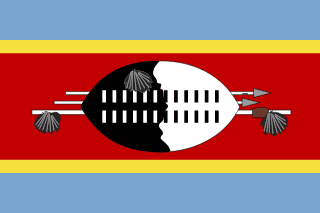Eswatini - Geography

Here, let us take a look at the Geography of Eswatini. Landlocked; almost completely surrounded by South Africa. Mother's mean age at first birth is (), whereas, the Maternal mortality ratio is 437 deaths/100,000 live births (2017 est.)
Geographical data of Eswatini
| Location | Southern Africa, between Mozambique and South Africa |
|---|---|
| Geographic coordinates | 26 30 S, 31 30 E |
| Map references | Africa |
| Tarrain | mostly mountains and hills; some moderately sloping plains |
| Natural Resources | asbestos, coal, clay, cassiterite, hydropower, forests, small gold and diamond deposits, quarry stone, and talc |
| Natural Hazards | drought |
| Irrigated Land | 500 sq km (2012) |
| Major rivers (by length in km) | |
| Major aquifers | |
| Land Boundaries | 546 km |
| Border Countries | Mozambique 108 km; South Africa 438 km |
| Coastline | 0 km (landlocked) |
| Climate | varies from tropical to near temperate |
| Area | |
| Total Area | |
| Land Area | 17,204 sq km |
| Water Area | 160 sq km |
| comparative Area | slightly smaller than New Jersey |
| Maritime Claims | |
| Elevations | |
| Highest point | Emlembe 1,862 m |
| Lowest point | Great Usutu River 21 m |
| Mean elevation | 305 m |
| Land Use | |
| Agricultural land | 69.5% (2022 est.) |
| Agricultural land: arable land | arable land: 10.3% (2022 est.) |
| Agricultural land: permanent crops | permanent crops: 1% (2022 est.) |
| Agricultural land: permanent pasture | permanent pasture: 58.1% (2022 est.) |
| Forest | 29.1% (2022 est.) |
| Other | 1.5% (2022 est.) |
Population Distribution
Because of its mountainous terrain, the population distribution is uneven throughout the country, concentrating primarily in valleys and plains as shown in this population distribution map
People and Society
In Eswatini, the different Ethnic groups are such that we have:
predominantly Swazi; smaller populations of other African ethnic groups, including the Zulu, as well as people of European ancestry
| Population | |
|---|---|
| Pop growth rate | 0.7% (2024 est.) |
| Birth rate | 22.3 births/1,000 population (2024 est.) |
| Death rate | 9.4 deaths/1,000 population (2024 est.) |
| Health expenditure | |
| Physicians Density | |
| Hospital bed Density | |
| Total fertility rate | 2.37 children born/woman (2024 est.) |
| Gross reproduction rate | 1.17 (2024 est.) |
| Contraceptive prevalence rate | 66.1% (2014) |
| Est married women (ages 15-49) | 37.1% (2023 est.) |
| Literacy | |
| Education expenditures | |
| Net Migration rate | -6 migrant(s)/1,000 population (2024 est.) |
| Nationality | Swati; note - former term, Swazi, still used among English speakers | liSwati (singular), emaSwati (plural); note - former term, Swazi(s), still used among English speakers |
| Languages | English (official, used for government business), siSwati (official) |
| Religions | Christian 90% (Zionist - a blend of Christianity and traditional African religions - 40%, Roman Catholic 20%, other Christian 30% - includes Anglican, Methodist, Church of Jesus Christ, Jehovah's Witness), Muslim 2%, other 8% (includes Baha'i, Buddhist, Hindu, indigenous, Jewish) (2015 est.) |
| Age Structure | |
| 0-14 years | 31.6% (male 180,328/female 179,840) |
| 15-64 years | 64.3% (male 341,298/female 390,884) |
| 65 years and over | 4% (2024 est.) (male 16,974/female 28,765) |
| Dependency Ratios | |
| Total dependency ratio | 55.4 (2024 est.) |
| Youth dependency ratio | 49.2 (2024 est.) |
| Elderly dependency ratio | 6.2 (2024 est.) |
| Potential support ratio | 16 (2024 est.) |
| Median Age | |
| Total | 24.6 years (2024 est.) |
| Male | 23.4 years |
| Female | 25.8 years |
| Urbanization | |
| Urban population | 24.8% of total population (2023) |
| Rate of urbanization | 2.42% annual rate of change (2020-25 est.) |
| Major urban areas (Pop) | 68,000 MBABANE (capital) (2018). |
| Sex Ratio | |
| At birth | 1.03 male(s)/female |
| 0-14 years | 1 male(s)/female |
| 15-64 years | 0.87 male(s)/female |
| 65 years and over | 0.59 male(s)/female |
| Total population | 0.9 male(s)/female (2024 est.) |
| Infant Motality | |
| Total | 36.7 deaths/1,000 live births (2024 est.) |
| Male | 40.7 deaths/1,000 live births |
| Female | 32.5 deaths/1,000 live births |
| Life Expectancy at birth | |
| Total population | 60.7 years (2024 est.) |
| Male | 58.7 years |
| Female | 62.8 years |
| Drinking Water Sources | |
| Improved: urban | urban: 97.5% of population |
| Improved: rural | rural: 74.8% of population |
| Improved: total | total: 80.3% of population |
| Unimproved: urban | urban: 2.5% of population |
| Unimproved: rural | rural: 25.2% of population |
| Unimproved: total | total: 19.7% of population (2020 est.) |
| Sanitation facility acess | |
| Improved: urban | urban: 92.3% of population |
| Improved: rural | rural: 83.9% of population |
| Improved: total | total: 85.9% of population |
| Unimproved: urban | urban: 7.7% of population |
| Unimproved: rural | rural: 16.1% of population |
| Unimproved: total | total: 14.1% of population (2020 est.) |
| Alcohol consumption per capita | |
| Total | 7.68 liters of pure alcohol (2019 est.) |
| Beer | 2.45 liters of pure alcohol (2019 est.) |
| Wine | 0.06 liters of pure alcohol (2019 est.) |
| Spirits | 0 liters of pure alcohol (2019 est.) |
| Other alcohols | 5.17 liters of pure alcohol (2019 est.) |
| Tobacco use | |
| Total | 8.5% (2025 est.) |
| Male | 16.1% (2025 est.) |
| Female | 1.2% (2025 est.) |
| Child marriage | |
| Women married by age 15 | 0.1% (2022) |
| Women married by age 18 | 1.9% (2022) |
| Men married by age 18 | 0% (2022) |
Demographic profile
All Important Facts about Eswatini
Want to know more about Eswatini? Check all different factbooks for Eswatini below.









